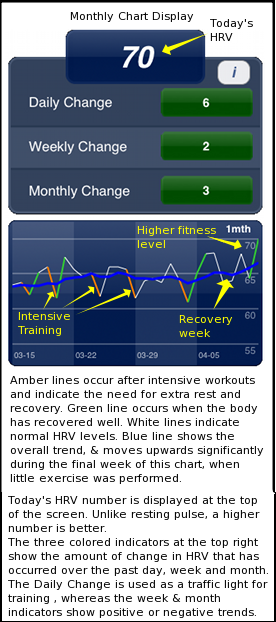Heart Rate Variability Testing
Heart Rate Variability (HRV) was solely used by a small group of world-class athletes and their coaches. Now we can use it to HELP YOU LOSS WEIGHT!
What is the Heart Rate Variability Stress and Recovery Test (HRV) and how can it be used?
No pain, no gain. Right?
But what’s missing here is another critical aspect of training: rest and recovery. Over training leads to injury, illness and diminished performance. The body can endure just so much continual physical stress before it begins to break down.
So how do you know when to train and when to rest? The answer is heart-rate variability which measures the time-gap between your heartbeats when you’re resting. The heart, in fact, speeds up when you inhale, and slows down when you exhale. The difference is known as heart-rate variability (HRV). A healthy, well rested body will produce a wider gap than a stressed out, over trained body.
Most endurance athletes are familiar with heart-rate monitoring during training and racing. But measuring your heart-rate variability is something you do at home, usually right after you wake up. HRV is not unlike the morning ritual of taking your resting heart rate to determine fatigue, over training or approaching illness. But measuring and tracking heart rate variability presents a more precise picture of your overall health. A high reading combined with a normal resting pulse is good news– you can train hard that day. A low reading means you should take it easy, providing you with a guilt-free rest day. And while your body is in recovery mode, your muscles are busy getting stronger.
That’s because: training & Weight Loss = workout + recovery
Heart Rate Variability (HRV) is one method being used to evaluate the stress of a person or athlete and determine if they are in a more sympathetic or parasympathetic state, which would then guide the training program for that day.
Having a high HRV corresponds with a high Vo2222222max, while having a low HRV can be an indicator of increased stress on the body, mortality and possible cardiac events.
If you have a low HRV and your body is under a lot of stress, the last thing you should be doing is exercising a lot at a high heart rate. This only causes MORE stress on the body and your body will NOT LOSE WEIGHT UNDER THESE CONDITIONS
In a nutshell, when HRV is high, this can be taken as an indicator of a parasympathetic state and being well rested. When HRV is low it suggest sympathetic dominance , high stress, and a potentially over trained state.
The sympathetic system is the FIGHT OR FLIGHT system. It is only suppose to be used for short time. However, in our world of high stress job, family, Red Bulls, Coffee, the FIGHT OR FLIGHT SYSTEM sometimes is ALWAYS ON.
If HRV is low, back off that day, lower the intensity and volume, or take an off-day and recover.
If HRV is high, then training today is business as usual. Another interesting thing to evaluate is how well the athlete recovers following a high stress situation like competition. Athletes who are better conditioned will return to a parasympathetic state faster than those with poor conditioning. This information can be used to plan training the day after competition for individual athletes.
 Trained athletes have higher HRV, HRV, and increased R-R interval times compared to untrained individuals. Additionally, as noted above, athletes who are in better condition are often able to recover at a faster rate following intense bouts of training and competition.
Trained athletes have higher HRV, HRV, and increased R-R interval times compared to untrained individuals. Additionally, as noted above, athletes who are in better condition are often able to recover at a faster rate following intense bouts of training and competition.
Pain Relief Acupuncture Fitness Weight Loss Superhuman Coach